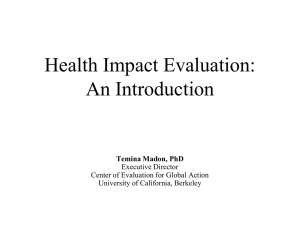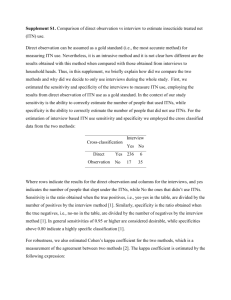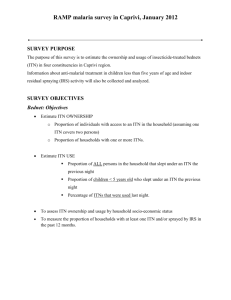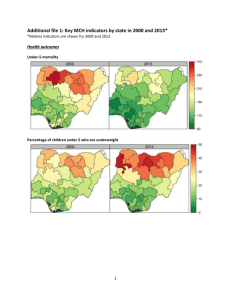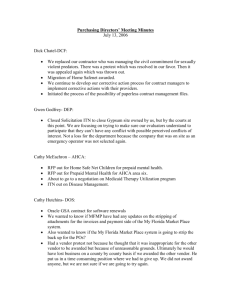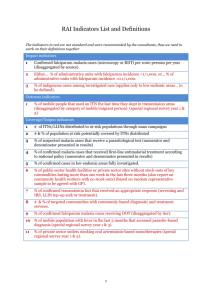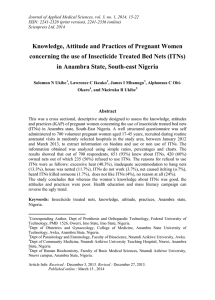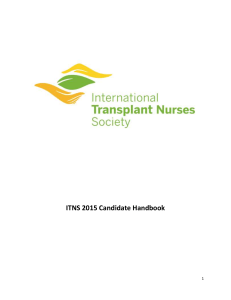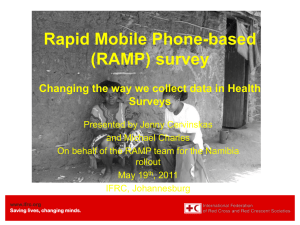Debriefing tools: Powerpoint
advertisement
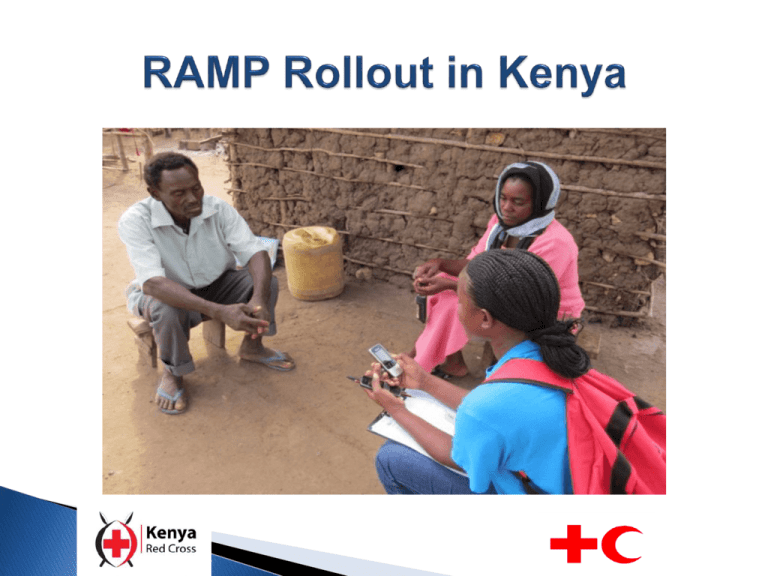
Presented by Kioko Kiilu (KRCS) Jenny Cervinskas (IFRC) Nairobi, February 1st, 2011 Introduction to Rapid Mobile Phone-based (RAMP) survey RAMP experience with KRCS volunteers ◦ Site and project identification ◦ Survey methods, training, fieldwork ◦ Lessons learnt Preliminary results Plenary To provide a survey methodology and operations protocol so that governments and NGOs can: ◦ conduct health surveys at reduced cost ◦ with limited external technical assistance ◦ and achieve high standards of data quality Dramatically decrease the time from data collection to having data available for decision making Technical Reference Manual Standardized questionnaires for malaria Questionnaires designed on the internet using EpiSurveyor Data collected using cell phones Training manual and tools adaptable to local settings Standard survey methods Rapid analysis and reporting of results Questionnaire Design Weeks to Months (sometimes continuous) Data Collection Weeks to Months (sometimes continuous) Data Entry Weeks to Months to Years Data Analysis Weeks to Months to Years Data Reporting ACTION Weeks to Months to Years (or never) Mobile technology can drastically reduce the time between data collection and action. Questionnaire Design EpiSurveyor has: ◦ eliminated the need for data entry and is now automating many analysis and reporting functions ◦ shortened the time and reduced the costs between collection and action Data Collection Data Entry Data Analysis Data Reporting ACTION Anyone can create a username and password at www.episurveyor.org and start using these tools for free Questionnaire design in Episurveyor (internet) Real-time data entry on cell phones Daily upload of data from cell phone over 2G cell network to internet database Real-time data cleaning Real-time data analysis Rapid production of preliminary survey results bulletin within 24 hours of last interview Rapid production of preliminary feedback survey report in 72 hours Ongoing operational research project in malaria Hard-to-reach areas/Long data cycle Mobile network coverage Project: Home Management of Malaria (HMM) in Malindi district, Coast province 1st stage: standard probability-proportional-toestimated-size (PPES) selection of PSUs ◦ Sampling frame: 106 villages of the HMM project 2nd stage: segmentation of PSU; choose 1 segment using PPES SRS to choose 10 households Precision: +/- 6% for each key indicator from household questions +/- 3% using roster/individual data 30 PSUs, 10 households per PSU, 1500 persons, all ages Household questionnaire ◦ Usual household characteristics (wealth asset questions, distance to health facility, etc.) ◦ Summary questions (innovation) Duplicated nearly all key indicators that are in the person & net register Eg., no. of persons: all ages & children <5 yo No. of any nets, ITNs No. of persons/children <5 yo slept under ITN last night Person roster Net roster ◦ Number of persons that slept under each net HMM volunteers (Interviewers) HMM Coaches /MOH Public Health Officers (PHOs) (Supervisors) Training – 4 days (January 19-22, 2011) Content ◦ ◦ ◦ ◦ ◦ ◦ ◦ Cellphone basics Questionnaires Informed consent Interview techniques Field procedures Field logistics/reporting Supervisor training Methodology ◦ Presentations, role play, group discussion, demonstrations, field tests (2) Survey teams: ◦ 6 teams 1 Team supervisor and 2-4 interviewers/team) Survey supervisory team (KRC, IFRC, WHO, MOH, DataDyne): ◦ Planning, logistic & financial responsibilities, field support, daily “quality” rounds, and remote monitoring of data quality Morning briefing (“quality round”) Meeting with community leaders, reviewing sketch maps, segmentation, selection of HHs Conduct interviews at HH level Supervisor will send data to server Debriefing at day’s end with support team in Malindi Data cleaning and analysis Data entry: worked well, all teams were able to collect data using the cellphone and send to server Survey conducted with reasonable adherence to correct field procedures KRC volunteers were able to prepare the sketch maps, carry out segmentation, and apply SRS to select HHs Preliminary results were available within 24 hrs. of the return of the last team from the field Percentage 100 90 80 70 60 79 78 77 69 68 65 55 50 40 30 20 14 10 0 HH ownership Access, % pop. Use, all persons Use, children Use in children Of <5y fever Of <5y fever Of <5y fever at least one ITN with access to <5 years <5y, given at cases, treated cases, treated cases, blood ITN least 1 ITN ACT ACT within 24 taken (testing) hr Key indicators Target population Persons per net ITNs needed Survey-estimated ITNs in HH of target pop ITN/LLIN need/gap 68 753 2.47 27 835 18 931 (68%) 8 904 (32%) Key indicators Point estimate % ITNs that were slept under last night 87% % ITNs that were hung last night 86% ITN use, all ages 55% ITN use, <5 yo 65% * 47% of nets had 3 or 4 persons sleeping under them 100 90 80 70 60 50 40 30 20 10 0 <1y 1 2-4 5-9 10-14 Age groups (years) 15-24 25-44 45-59 60+ Age of ITNs Age in months Cumulative % <12 months 28 12-23 months 59 24-36 months 80 * 88% of nets were LLINs Key results from roster-only data Number of persons sleeping under a single net last night %, nets 1 person 15 2 persons 39 3 persons 32 4 persons 15 Key indicators % Treated ACT, <5 yo 77 Treated ACT within 24 hours, <5 yo 69 Received finger/heal stick for blood 14 - Denominator for all indicators was % of children <5y with fever in the previous two weeks No major problems: all cellphones were operational No calls to the Datadyne “hotline” Data entry: worked well Data was sent to the server by all teams, every day Daily/immediate upload of data if 2G/GPRS available Potential difficulties: initial connection of cell phone to data network Conducted by secondary-school graduates with no previous survey experience Survey was completed within two weeks ◦ 1 week training, 4.5 days field work Daily data cleaning accomplished Preliminary survey results bulletin finished within 24 hours Preliminary report finished within 72 hours Provided excellent management information on the key indicators Cost component USD Local operational costs (e.g., personnel costs: avg. $40 per interviewer & supervisor/day * 20 persons * 10 days, training hall, stationary) 13 429 Phones + accessories 5 416 Transport (drivers, fuel) 3 950 Total 22 795 Approx Kshs 1.7m Analysis + Report Free (WHO) • • • • • • Kenya Red Cross Volunteers Kenya Ministry of Public Health and Sanitation IFRC Datadyne WHO Kenya Bureau of Statistics A special thanks to the survey team and the many families who agreed to be interviewed for this survey Thank-you for your attention
